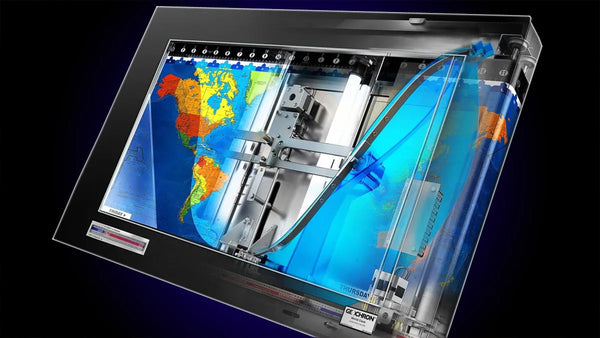- Australia ▾
- Topographic
▾
- Australia AUSTopo 250k (2024)
- Australia 50k Geoscience maps
- Australia 100k Geoscience maps
- Australia 250k Geoscience maps
- Australia 1.1m Geoscience maps
- New Zealand 50k maps
- New Zealand 250k maps
- New South Wales 25k maps
- New South Wales 50k maps
- New South Wales 100k maps
- Queensland 10k maps
- Queensland 25k maps
- Queensland 50k maps
- Queensland 100k maps
- Compasses
- Software
- GPS Systems
- Orienteering
- International ▾
- Wall Maps
▾
- World
- Australia & New Zealand
- Countries, Continents & Regions
- Historical
- Vintage National Geographic
- Australian Capital Territory
- New South Wales
- Northern Territory
- Queensland
- South Australia
- Tasmania
- Victoria
- Western Australia
- Celestial
- Children's
- Mining & Resources
- Wine Maps
- Healthcare
- Postcode Maps
- Electoral Maps
- Nautical ▾
- Flags
▾
- Australian Flag Sets & Banners
- Flag Bunting
- Handwavers
- Australian National Flags
- Aboriginal Flags
- Torres Strait Islander Flags
- International Flags
- Flagpoles & Accessories
- Australian Capital Territory Flags
- New South Wales Flags
- Northern Territory Flags
- Queensland Flags
- South Australia Flags
- Tasmania Flags
- Victoria Flags
- Western Australia Flags
- Gifts ▾
- Globes ▾
Dear valued customer. Please note that our checkout is not supported by old browsers. Please use a recent browser to access all checkout capabilities
Tracks, Trails & Tassie Tales: A Rambler’s and Rover’s Guide to Tasmania

There’s a saying whispered in mountain huts and campfire circles around the country: “If you want to know if someone’s ready for Tasmania, take them to Victoria. If they survive the Great Ocean Road in summer, then send them into the wild.”
But Tasmania isn’t merely wild. It’s cultured wilderness. It wears its chaos with elegance. It’s a place where primordial forest rubs shoulders with architectural cheese platters, where sea spray collides with convict ruins, and where, somewhere between Cradle Mountain and a sudden snow flurry in November, you realise that this is not the Australia you thought you knew.
This is a land of extremes—geographic, meteorological, and emotional—and whether you're bushwalking across its alpine spines or thundering down a 4WD track laced with river crossings and reasonable doubt, one thing is certain: you need the Tasmania Atlas & Guide by Hema Maps.
A map in Tasmania is not a luxury. It’s a lifeline. And Hema’s version isn’t merely functional—it’s a cartographic confession from someone who’s been there, survived, and very nearly reversed into a wombat while looking for a waterfall.
So. You want to walk it? Drive it? Camp beside it? Get bogged in it? This is how to do it properly.
PART I: WALKING TASMANIA – IN THE FOOTSTEPS OF FROST, FERN, AND FANTASY
1. The Overland Track – Tasmania’s Long March to Enlightenment
Let’s begin, naturally, at the top.
The Overland Track is the stuff of bushwalking legend. Stretching some 65 kilometres from Cradle Mountain to Lake St Clair, it’s often called a "six-day journey through geological time"—which is a polite way of saying you’ll freeze, sweat, curse, and possibly cry, but emerge transformed.
Hema’s atlas outlines the entire route with 1:50,000 topographic precision, side-trails, hut locations, and water sources. The permits (yes, required), weather warnings, and suggestions for diverting up Mount Ossa are all there too, packaged in the sober tone of someone who knows what happens when you forget your gaiters.
This is not a walk you do lightly. But then, Tasmania doesn’t do “light.”
2. The Walls of Jerusalem – Alpine Holiness
You enter this Tasmanian high country wilderness on foot. No roads. No easy exits. Just a steep, rocky trail and a promise that you’ll find yourself somewhere between Solomon’s Throne and The Temple—named by early cartographers with more biblical imagination than hiking shoes.
The Walls of Jerusalem offer a labyrinth of glacial tarns, pencil pine forests, and rocky outcrops that look like God had a few extra granite blocks left over.
The Hema guide provides contour-heavy maps, detailed notes on access from Lake Rowallan, and camping zones, including the beloved Wild Dog Creek, which is neither particularly wild, nor particularly canine—but scenic nonetheless.
Be warned: snow can fall in any season, and if you’re not comfortable navigating in fog with only a headlamp, perhaps stick to the wine trails.
3. The South Coast Track – Tasmania’s Lovely, Leechy Nemesis
This is for the hard ones. The masochists. The people who hike with duct tape and eat protein bars made from beetles.
Accessible only by light aircraft to Melaleuca, the South Coast Track drags you through 85 kilometres of beaches, rainforest, button grass plains, and the kind of mud that clings to your boots and soul.
It’s six to eight days of remoteness. River crossings. Wet boots. But also: quartzite peaks, roaring surf, and sunsets so spectacular they make up for the stench of your damp socks.
Hema’s atlas is essential here. It marks campsites, water points, and creek crossings with a detail that suggests someone really did the walk with a ruler and a vengeance.
If the Overland is a pilgrimage, the South Coast Track is a wilderness crucible.
4. The Three Capes Track – Luxury in Gaiters
Let us now turn to Tasmania’s spa day of hikes.
The Three Capes Track, on the Tasman Peninsula, is a carefully curated four-day hike with boardwalks, design-forward huts, and interpretive panels that make you feel like you’re starring in your own documentary.
You don’t need a tent. You don’t need a map. But bring the Hema anyway—its maps detail the surrounding Cape Pillar area for those who want to extend the experience (or pretend they’re roughing it).
This is Tasmania’s accessible wilderness—the one you bring your parents to. Or your partner who’s not quite convinced hiking is “relaxing.”
5. Frenchmans Cap – A Vertical Love Letter to Suffering
And finally, for the poet-masochists among us: Frenchmans Cap.
This summit walk is 46km return, with 1,400m of vertical gain, a mud pit known charmingly as the Lodden Plains, and a final ascent that will question your life choices.
But the view from the top? All of Tasmania, unspooling in waves of peaks, plains and cloud.
The Hema Atlas includes side notes on huts, water catchments, and the improvements made by convicts with shovels and moral outrage.
This is one for the brave. And possibly the unwise. Bring scroggin and a sense of humour.
PART II: 4WD TASMANIA – LOW RANGE, HIGH ADRENALINE
1. Climies Track – West Coast Apocalypse
If Tasmania’s trails are harsh but noble, its 4WD tracks are borderline sadistic.
Climies Track between Granville Harbour and Trial Harbour is considered one of the most technical, remote, and unpredictable tracks in the country.
Here you will find:
-
Boulder fields
-
Washed-out ravines
-
Tracks disappearing into the sea
-
And locals who just smile and say, “Bit greasy today.”
The Hema Guide shows every switchback, washout, and bailout option. It labels Climies as “Very Difficult”, which is code for bring friends and a winch.
Don’t go alone. Don’t go unprepared. And don’t believe the bloke at the pub who says, “You’ll be right in a Subaru.”
2. Sandy Cape Track – Where Ocean and Engine Meet
Northwest Tasmania meets Mad Max here.
The Sandy Cape Track starts with the Pieman River barge crossing, then barrels onto vast, tidal beaches flanked by windblown dunes and Antarctic gales.
You’ll need:
-
Low-range 4WD
-
Tread lightly ethics
-
A tide chart (non-negotiable)
-
And your Hema map open to Section 9
The inland sections are swampy. The beach can swallow you whole. But the rewards are immense: solitude, shipwrecks, and sand as far as the eye can squint.
Just remember: bogged here means helicopter extraction.
3. Jefferys Track – Hobart’s Dirty Secret
Twenty minutes from a flat white, and you’re in 4WD heaven.
Jefferys Track connects Lachlan and Crabtree, winding through forest, clay, and mud. Lots of mud.
It’s used by local clubs as a proving ground. It’s short enough for a day trip, but slick enough to need snatch straps and low tyre pressure.
The Hema Atlas provides a delightful fold-out on this region, including how rain turns the track from adventurous to impassable in about 20 minutes.
This is the kind of track where you go in with pride and come out with character.
4. Arthur River and Beyond – Tasmania’s West Coast Fringe
The northwest corner is a place where wind shapes landscape, and salt shapes vehicles.
From Temma to Sandy Cape, you’ll find coastal 4WD tracks unlike anything else on the island. They’re remote, exposed, and beautiful in that windburned, bleached-wood kind of way.
You’ll need to carry everything:
-
Fuel
-
Food
-
Recovery gear
-
A taste for silence
Hema’s atlas lays it all out—coastal camps, creek crossings, and how far you can push inland before the forest wins.
PART III: THE DETAILS THAT MATTER
Camping & Accommodation
Tasmania offers everything from remote bush camps to boutique B&Bs with kelp soap and organic tea. The Hema Guide doesn’t judge—it lists both.
For campers, there are hundreds of marked sites, including:
-
Free forest camps
-
National park sites (permits required)
-
4WD-access-only beach spots
Fuel & Food
Fuel stops thin out in the west. Always check the guide for:
-
Opening hours
-
Fuel type availability (not everywhere stocks diesel)
-
Maximum distances between bowsers
Food? Pub meals, road pies, and trout (if you’re lucky). Also: never trust a roadhouse sandwich that doesn’t list a best-before date.
Navigation
The Tasmania Atlas includes:
-
Town maps
-
Remote region blowouts
-
Elevation profiles
-
GPS coordinates
-
And "Travellers’ Notes" which are like friendly warnings written by someone who’s been bogged too many times
And it’s spiral-bound. Because Hema understands that you’ll be opening it with muddy fingers and rain on your brow.
CONCLUSION: THE ISLAND THAT WALKS BACK
Tasmania doesn’t just offer adventure. It insists on it. It pulls you into its wilderness, tests your knees and diff locks, and then offers you a view that resets your understanding of beauty.
And all along the way, in your glovebox or backpack, your Tasmania Atlas & Guide by Hema Maps will be there—dog-eared, damp, and noble.
Because here’s the thing: in Tassie, it’s not about the shortest route. It’s about the most interesting one.
So take the scenic route. Take the difficult track. Take the long way home.
And take the Hema.
Leave a comment
Comments will be approved before showing up.
Also in Travel Writings / Product Reviews

Club Med Phuket: Our Full Week in Review
Whether you’re a family chasing a balance between togetherness and independence, a couple craving peace and cocktails, or simply someone ready to trade routine for ritual—this is your place.

Where the Sun Never Sets: A Glorious History of Geochron World Clocks
The Geochron, whether mechanical or digital, offers more than information. It offers perspective. It reasserts the idea that we are part of a rotating story—lit by the sun, divided by clocks, and unified by the gentle ticking of planetary rhythm.

Greenland for Sale? A Gall–Peters Perspective on Cartographic Ego and Arctic Aspirations
The next time someone proposes to buy a country, they’ll pause. They’ll consult a different map. One that doesn’t overstate the icy or understate the equatorial.
Christopher O'Keeffe
Author